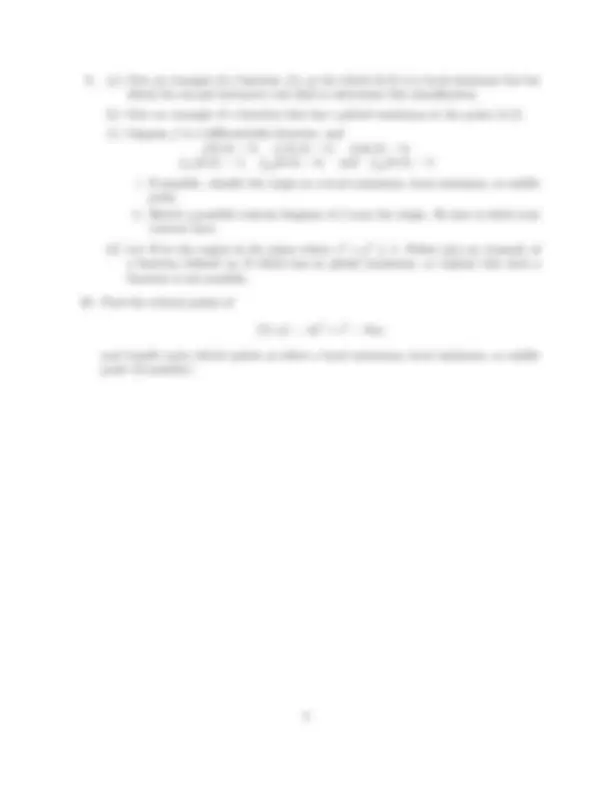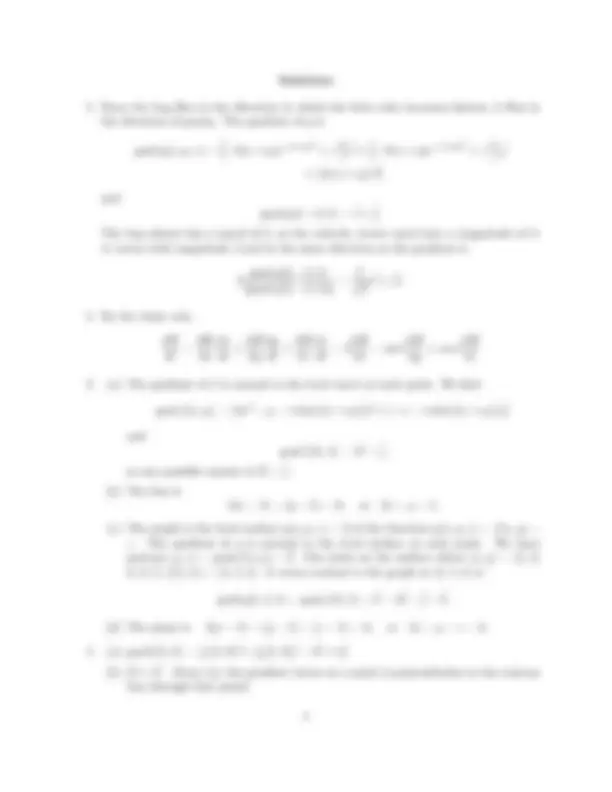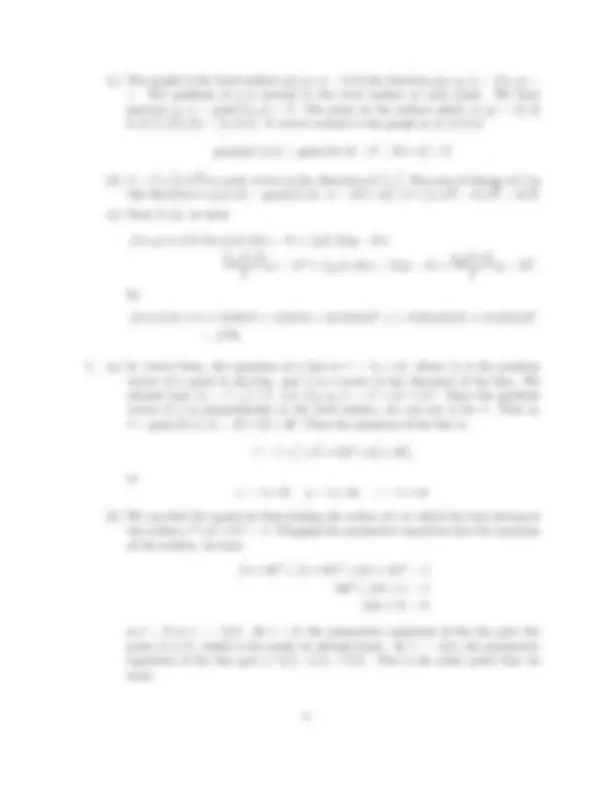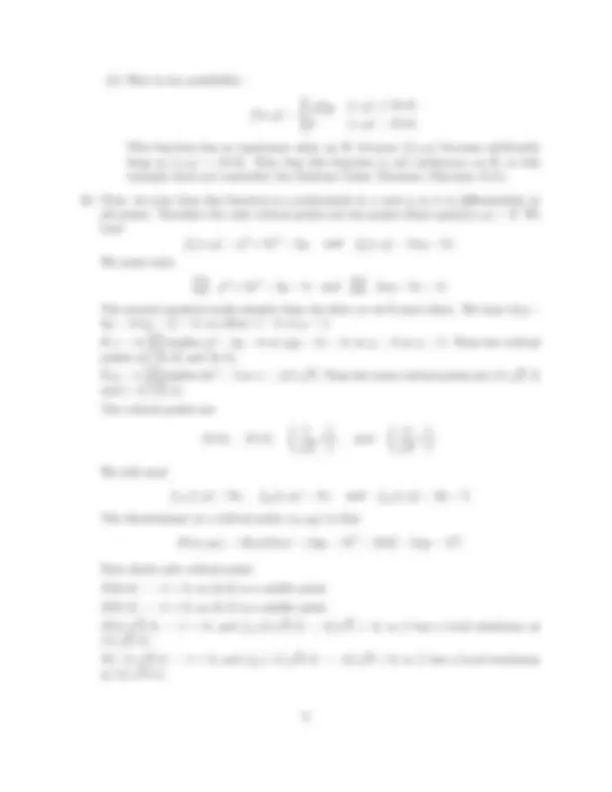






Study with the several resources on Docsity

Earn points by helping other students or get them with a premium plan


Prepare for your exams
Study with the several resources on Docsity

Earn points to download
Earn points by helping other students or get them with a premium plan
Community
Ask the community for help and clear up your study doubts
Discover the best universities in your country according to Docsity users
Free resources
Download our free guides on studying techniques, anxiety management strategies, and thesis advice from Docsity tutors
A collection of calculus problems aimed at finding gradients, normal vectors, and tangent lines of functions and surfaces. The problems involve finding the derivatives of functions, level curves, and level surfaces, as well as the normal vectors and equations of the tangent lines.
Typology: Exams
1 / 8

This page cannot be seen from the preview
Don't miss anything!





Math 113 – Calculus III Exam 3 Practice Problems Spring 2004
g(x, y, z) = e
−(x+y)
2
2
(x + y).
Suppose that a piece of fruit is sitting on a table in a room, and at each point (x, y, z)
in the space within the room, g(x, y, z) gives the strength of the odor of the fruit.
Furthermore, suppose that a certain bug always flies in the direction in which the
fruit odor increases fastest. Suppose also that the bug always flies with a speed of 2
feet/second.
What is the velocity vector of the bug when it is at the position (2, − 2 , 1)?
z(t) = sin(t). Suppose the temperature in this space is given by a function H(x, y, z).
Find
dH
dt
, the rate of change of the temperature at the particle’s position. (Since the
actual function H(x, y, z) is not given, your answer will be in terms of derivatives of
f (x, y) = x
3
− xy + cos(π(x + y)).
(a) Find a vector normal to the level curve f (x, y) = 1 at the point where x = 1,
y = 1.
(b) Find the equation of the line tangent to the level curve f (x, y) = 1 at the point
where x = 1, y = 1.
(c) Find a vector normal to the graph z = f (x, y) at the point x = 1, y = 1.
(d) Find the equation of the plane tangent to the graph z = f (x, y) at the point
x = 1, y = 1.
f (1, 3) = 1, f x
(1, 3) = 2, f y
f xx
(1, 3) = 2, f xy
(1, 3) = − 1 , and f yy
(a) Find gradf (1, 3).
(b) Find a vector in the plane that is perpendicular to the contour line f (x, y) = 1 at
the point (1, 3).
(c) Find a vector that is perpendicular to the surface z = f (x, y) (i.e. the graph of
f ) at the point (1, 3 , 1).
(d) At the point (1, 3), what is the rate of change of f in the direction
i +
j?
(e) Use a quadratic approximation to estimate f (1. 2 , 3 .3).
line is normal to (i.e. perpendicular to) the tangent plane of the surface at that point.
Let S be the surface defined by
x
2
2
2
= 4.
(a) Find the parametric equations of the line that is normal to the surface S at the
point (1, 1 , 1).
(b) The line found in (a) will intersect the surface S at two points. One of them is
(1, 1 , 1), by construction. Find the other point of intersection.
f (x, y) = (x − y)
3
2
− y.
(a) Find the function L(x, y) that gives the linear approximation of f near the point
(b) Find the function Q(x, y) that gives the quadratic approximation of f near the
point (1, 2)
not differentiable. Briefly explain how you know it is not differentiable; use a picture
if it helps.
(You do not have to prove that it is not differentiable; just identify the set of points
based on your understanding of what differentiable means.)
(a) f (x, y) =
x
2
2
− 1
(b) f (x, y) = (x
2
2
)
1 / 4
(c) f (x, y) = e
−x
2 +y
(d) f (x, y) =
x
3 − xy + 1
x
2 − y
2
x = f (t), y = g(t) and z = h(t).
(a) Use the chain rule to find an expression for
dw
dt
in terms of Q, f , g, h and their
derivatives (e.g. Q x
, f
′
, etc.).
(b) Show that the expression in (a) may be written as
dw
dt
= (grad Q(~r(t)) ·
d~r
dt
where · is the dot product, ~r(t) = f (t)
i + g(t)
j + h(t)
k is the vector form of the
parameterized curve x = f (t), y = g(t), and z = h(t), and, if ~r = a~i + b~j + c
k,
Q(~r) means Q(a, b, c).
Solutions
the direction of grad g. The gradient of g is
grad g(x, y, z) =
−2(x + y)e
−(x+y)
2
2
i +
−2(x + y)e
−(x+y)
2
2
j
k,
and
grad g(2, − 2 , 1) =
i +
j.
The bug always has a speed of 2, so the velocity vector must have a magnitude of 2.
A vector with magnitude 2 and in the same direction as the gradient is
grad g(2, − 2 , 1)
‖grad g(2, − 2 , 1)‖
i +
j).
dH
dt
∂x
dx
dt
∂y
dy
dt
∂z
dz
dt
∂x
− sin t
∂y
∂z
grad f (x, y) = (3x
2
− y − π sin(π(x + y)))
i + (−x − π sin(π(x + y)))
j,
and
grad f (1, 1) = 2
i −
j,
so one possible answer is 2
i −
j.
(b) The line is
2(x − 1) − (y − 1) = 0, or 2 x − y = 1.
(c) The graph is the level surface g(x, y, z) = 0 of the function g(x, y, z) = f (x, y) −
z. The gradient of g is normal to the level surface at each point. We have
grad g(x, y, z) = grad f (x, y) −
k. The point on the surface where (x, y) = (1, 1)
is (1, 1 , f (1, 1)) = (1, 1 , 1). A vector normal to the graph at (1, 1 , 1) is
grad g(1, 1 , 1) = grad f (1, 1) −
k = 2
i −
j −
k.
(d) The plane is 2(x − 1) − (y − 1) − (z − 1) = 0, or 2 x − y − z = 0.
i + f y
j = 2
i + 4
j
(b) 2
i + 4
i (from (a); the gradient vector at a point is perpendicular to the contour
line through that point)
(c) The graph is the level surface g(x, y, z) = 0 of the function g(x, y, z) = f (x, y) −
z. The gradient of g is normal to the level surface at each point. We have
grad g(x, y, z) = grad f (x, y) −
k. The point on the surface where (x, y) = (1, 3)
is (1, 3 , f (1, 3)) = (1, 3 , 1). A vector normal to the graph at (1, 3 , 1) is
grad g(1, 3 , 1) = grad f (1, 3) −
k = 2
i + 4
j −
k.
(d) ~u = (
i +
j)/
2 is a unit vector in the direction of
i +
j. The rate of change of f in
this direction is f ~u
(1, 3) = gradf (1, 3) · ~u = (
i + 4
j) · (
i +
j)/
(e) Near (1, 3), we have
f (x, y) ≈ f (1, 3)+f x
(1, 3)(x − 1) + f y
(1, 3)(y − 3)+
f xx
(x − 1)
2
(1, 3)(x − 1)(y − 3) +
f yy
(y − 3)
2
.
So
f (1. 2 , 3 .3) ≈ 1 + (2)(0.2) + (4)(0.3) + (2/2)(0.2)
2
2
is the position
vector of a point in the line, and ~v is a vector in the direction of the line. We
already have ~r 0
i +
j +
k. Let f (x, y, z) = x
2
2
2
. Since the gradient
vector of f is perpendicular to the level surface, we can use it for ~v. That is,
~v = grad f (1, 1 , 1) = 2
i + 2
j + 4
k. Thus the equation of the line is
~r =
i +
j +
k + t(
i + 2
j + 4
k),
or
x = 1 + 2t, y = 1 + 2t, z = 1 + 4t.
(b) We can find the points by first finding the values of t at which the line intersects
the surface x
2 +y
2 +2z
2 = 4. Plugging the parametric equations into the equation
of the surface, we have
(1 + 2t)
2
2
2
= 4
40 t
2
t(5t + 3) = 0
so t = 0 or t = − 3 /5. At t = 0, the parametric equations of the line give the
point (1, 1 , 1), which is the point we already knew. At t = − 3 /5, the parametric
equations of the line give (− 1 / 5 , − 1 / 5 , − 7 /5). This is the other point that we
want.
so we have
dw
dt
x
(~r(t))f
′
(t) + Q y
(~r(t))g
′
(t) + Q z
(~r(t))h
′
(t)
= (grad Q(~r(t)) ·
d~r
dt
4
4
. (See your class notes, or see Example 7 on
page 708 of the text.)
(b) A quadratic function seems like the simplest choice. One possible solution is
f (x, y) = −(x − 3)
2 − (y − 2)
2 .
(c) i. Since f x
(0, 0) = 0 and f y
(0, 0) = 0, we know (0, 0) is a critical point of f. We
find D = f xx
(0, 0)f yy
(0, 0) − f xy
2 = − 9 < 0, so (0, 0) is a saddle point.
ii. The second derivative test tells us that the graph is a saddle. (Since the
second derivative test is based on the degree 2 Taylor approximation, this is
not a “monkey saddle” or something more complicated.) Since f (0, 0) = 0,
we know two contour lines (where f (x, y) = 0) will meet at (0, 0). One of
these must be along the y axis, since fyy(0, 0) = 0. (If there was not a contour
line tangent to the y axis at (0, 0), we would not have f yy
(0, 0) = 0.) Now,
since fxy(0, 0) = 3, fx will increase along the positive y axis. This means that
f (x, y) > 0 just to the right of the positive y axis, and f (x, y) < 0 just to the
left of the positive y axis.
Since f xx
(0, 0) = 4 > 0, f (x, 0) > 0 along the x axis. Now consider the values
of f in the second quadrant (x < 0, y > 0). Near the x axis, f (x, y) > 0,
but near the y axis, f (x, y) < 0. So the contour line f (x, y) = 0 must cut
through the second quadrant. (It must also, therefore, cut through the fourth
quadrant.)
Here is a possible contour diagram:
−1 −0.5 0 0.5 1
−
−0.
0
1
x
y
−
−
−0.
−0.
0
0
0
0
0
0
1
1
1
1
2
2
2
This happens to be the function f (x, y) = 2x
2
to find an actual function to sketch a qualitatively correct contour diagram).
(d) Here is one possibility:
f (x, y) =
1
x
2 +y
2
(x, y) 6 = (0, 0)
0 (x, y) = (0, 0)
This function has no maximum value on R, because f (x, y) becomes arbitrarily
large as (x, y) → (0, 0). Note that this function is not continuous on R, so this
example does not contradict the Extreme Value Theorem (Theorem 15.1).
all points. Therefore the only critical points are the points where gradf (x, y) =
have
f x
(x, y) = y
2
2
− 2 y, and f y
(x, y) = 2xy − 2 x.
We must solve
1 y
2
2
− 2 y = 0 and 2 2 xy − 2 x = 0.
The second equation looks simpler than the first, so we’ll start there. We have 2xy −
2 y = 2x(y − 1) = 0, so either x = 0 or y = 1.
If x = 0, 1 implies y
2 − 2 y = 0 or y(y − 2) = 0, so y = 0 or y = 2. Thus two critical
points are (0, 0) and (0, 2).
If y = 1, 1 implies 3x
2 = 1 or x = ± 1 /
and (− 1 /
The critical points are
, and
We will need
f xx
(x, y) = 6x, f yy
(x, y) = 2x, and f xy
(x, y) = 2y − 2.
The discriminant at a critical point (x 0
, y 0
) is then
D(x 0 , y 0 ) = (6x 0 )(2x 0 ) − (2y 0 − 2)
2
= 12x
2
0
− 4(y 0 − 1)
2
.
Now check each critical point:
D(0, 0) = − 4 < 0, so (0, 0) is a saddle point.
D(0, 2) = − 4 < 0, so (0, 2) is a saddle point.
3 , 1) = 4 > 0, and f xx
3 > 0, so f has a local minimum at
3 , 1) = 4 > 0, and f xx
3 < 0, so f has a local maximum
at (1/